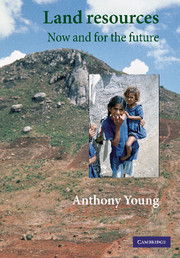Book contents
- Frontmatter
- Contents
- Preface
- Acknowledgements
- Note on acronyms and currency
- 1 Concern for land
- 2 Land resource issues
- 3 Resource survey and land evaluation
- 4 Competition for land
- 5 Working with farmers
- 6 Land use planning
- 7 Land degradation
- 8 Global issues: climatic change and biodiversity
- 9 Monitoring change: land resource indicators
- 10 Costing the earth: the economic value of land resources
- 11 Land management: caring for resources
- 12 Research and technology
- 13 Land, food, and people
- 14 Population, poverty, and conflict
- 15 Awareness, attitudes, and action
- Notes
- References
- Index
14 - Population, poverty, and conflict
Published online by Cambridge University Press: 04 August 2010
- Frontmatter
- Contents
- Preface
- Acknowledgements
- Note on acronyms and currency
- 1 Concern for land
- 2 Land resource issues
- 3 Resource survey and land evaluation
- 4 Competition for land
- 5 Working with farmers
- 6 Land use planning
- 7 Land degradation
- 8 Global issues: climatic change and biodiversity
- 9 Monitoring change: land resource indicators
- 10 Costing the earth: the economic value of land resources
- 11 Land management: caring for resources
- 12 Research and technology
- 13 Land, food, and people
- 14 Population, poverty, and conflict
- 15 Awareness, attitudes, and action
- Notes
- References
- Index
Summary
The present rate of world population increase, 240 000 people a day, poses immense problems, not least for land resource management. Future growth will nearly all take place in the developing world. Some countries, such as Bangladesh, Ethiopia, Malawi, Pakistan, and much of the African Sahelian zone, are already close to their limit for sustainable support to their people. Population increase will augment problems of landlessness, land degradation, and food security. Poverty and undernutrition add to these problems. There are also major consequences for human welfare or its opposite, suffering: direct links between population pressure and famine, and indirect but strong connections with civil conflict and war.
Scientists and governments have each made major international policy statements on population. Both accept the integral nature of population, economic growth, and environment, but there is one critical difference. The scientists state clearly that global social, economic, and environmental problems cannot be solved without an early approach to zero population growth, if possible within the lifetime of today's children. The governments could not commit themselves to such a statement. All are agreed on a set of ethically acceptable measures for reducing population growth, based on provision of family planning and reproductive health services, and measures to improve the welfare, education, and status of women. An immediate and major effort to apply such measures would contribute more than any other form of development to human welfare. Policy, planning, and action to check population growth is not merely an associated factor, but in the wider perspective is an integral part of land resource policy and management.
- Type
- Chapter
- Information
- Land ResourcesNow and for the Future, pp. 254 - 272Publisher: Cambridge University PressPrint publication year: 1998



